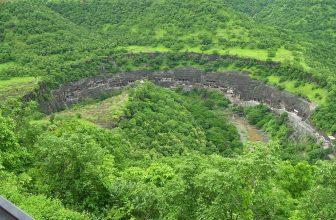Home » Sustainable Insights ( Blogs ) » Monday Flashback 22 – Gwalior Fort, Madhya Pradesh
Monday Flashback 22 – Gwalior Fort, Madhya Pradesh
THE GWALIOR FORT: GWALIOR
Gwalior Fort was assembled in 8th century by Suraj Sen. The castle stands on a retiring rock known as Gopachal. The fort was governed by many rulers of various reigns who also constructed many palaces and temples esoteric the fort. The united forces of Rani Lakshmi Bai and Tatya Tope also fought here against the British.Gwalior
Gwalior district is located in Madhya Pradesh state of India. The city, positioned nearby Agra, has many mosques, palaces, temples and other structures. Tomars, Mughals, Marathas, and Scindias ruled the city in different periods. The city has hot subtropical climate from March to June, hot and humid climate from July to October and winter from November to February. HISTORY According to a folklore, Gwalior was once governed by a king named Suraj Sen. A time came when he was suffering from leprosy which was undying. A astute named Gwalipa gave him water from a blessed pond which healed his disease. In order to honour the astute, the king built the fort. The king got the title of Pal from the astute and a windfall that the fort will be in his custody and the groups to come. History says that 83 generations of the king successfully ruled from this fort but the king of 84th generation named Tej Karan could not shield the fort and vanished it. TEMPLES Gwalior Fort is one of the colossal forts of India. It includes many structures like palaces, temples, and water tanks. The fort is banquet in an area of 3km and is constructed at a height of 35 feet. There are two gates to enter the fort. One of them is Hathi Pol or elephant gate and other one is Badalgarh gate. Elephant gate is the main entrance to the fort. Many temples are there which are still in use.Siddhachal Jain Temple Caves
Siddhachal Jain Temple Caves was built thru the period of 7th and 15th century. There are 32 Jain temples in the fort out of which eleven are faithful to the Jain Tirthankaras. The remaining ones are situated in south of the fort. Rishabhanath or Adinath was the first Jain Tirthankara and his ideal is the highest one as its height is 58 feet 4 inch or 17.78m.Urvashi Temple
Urvashi is a temple in the fortress that consists of many idols of Tirthankaras meeting in countless postures. There are 24 idols of Jain Tirthankaras sitting in the pose of padmasana. Another clutch of 40 idols are sitting in the position of kayotsarga. The number of idols pared in the bulwarks are 840.Gopachal
Gopachal is a hill which involves of 1500 pin-ups. The size of these ideals series from 6 inches to 57 feet. The era of figure these rock-cut leads is between 1341 and 1479. One of the largest idols is of Bhagwan Parsvanath whose height is 42bases and girth is 30 feet. 3. Gwalior Fort – Temples Gwalior Fort 8Teli ka Mandir
Teli ka mandir or oilman’s temple is said to have been made in 8th or 11th century and was modernized in 19th century. The temple contains north and south Indian architectural graces. The temple was constructed in quadrilateral shape and people can enter the temple through a set of steps. Gwalior Fort 9 The door of the temple includes the idols of river divinities on top and their guides at the lower part. From the door, disciples cross the threshold the garbha griha. It is said that hitherto the temple was dedicated to Lord Vishnu and was later dedicated to Lord Shiva. The outer and inner part of the door consists of Shaiva and Shakta dvarpalas. The outer walls are carved with the statues of many Hindu gods and goddesses. There is also a Garuda monument near the temple loyal to Lord Vishnu.Sas Bahu Temple
King Mahipal of Kachchhapaghata empire built Sas Bahu temple also well-known as Sahastrabahu temple. The area shielded by the temple is 32m x 22m. Aficionadas can enter the temple through three gates sited in three different directions. The main idols who are worshipped here are Brahma, Vishnu, and Saraswati and their ideals are located above the admission door. Gwalior Fort 10 The temple is called sas bahu temple because wife of Mahipal used to worship Lord Vishnu while her daughter-in-law used to piety Lord Shiva so another temple was constructed for her. GWALIOR FORT PALACES There are many palaces in the fort which are as tracks:Man Mandir
Man Mandir palace was built by Raja Man Singh between 1486AD and 1517AD. The outward of the palace was adorned with tiles and the walls include carvings of ducks variable in water. There were large rooms which assisted as a music room for royal women.Karan Mahal
Kirti Singh made this palace in the fort. He was the following king of Tomar dynasty. Karan Singh was another name of Kirti Singh and so the palace was entitled as Karan Mahal.Vikram Mahal
Vikramaditya Singh was the hoarier brother of Man Singh. He raised Vikram Mahal which was also known as Vikram Mandir because it had a temple of Lord Shiva which was ruined during the Mughal period. The temple has now been renovated in front of the palace.Gujari Mahal
Gujari Mahal was built by Raja Man Singh for his queen Mrignayani. She claimed a separate palace with endless water supply. The palace has now been changed into an archaeological exhibition hall. The museum now has weapons, statues, artifacts made of stones and other materials.SaveSavedRemoved 0








